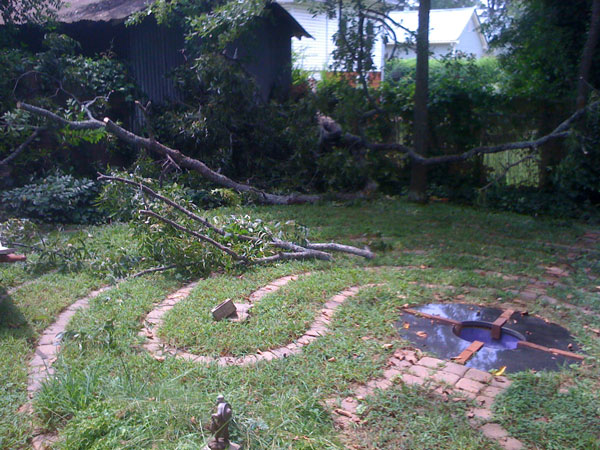Last weekend I took my lovely first wife to New York City for her birthday. We saw two exhibits and three shows, plus did a little shopping. It was a spectacular time.
We had never been to the Fashion Institute of Technology, down on 27th St, but the museum is free, and so we went. There was a nicely done exhibit of sportswear from the late 19th century to the present with some lovely examples. I especially liked the baseball shirt from the 1920s.
There was an exhibit of illustration masters students’ thesis work, and a lot of it was that surreal, drug-inspired stuff that litters the internet and magazine ads. (Although, have you seen the new Heineken commercial? Who spent that much money to do something that crafted for such a low-rent product?) The good stuff was all children’s illustrations: whimsical and beautifully rendered.
The highlight was an exhibit of items from Daphne Guinness’ “collection,” aka “her closet.” Daphne Guinness, for those who don’t know—of whom I count myself one—is a heiress of the ale concern. She’s excessively thin, tall, and glamorous, and she has made it her life’s work to be seen at events, dressed in over-the-top, one-of-a-kind outfits.
Having seen the Alexander McQueen exhibit at the Met back in June, we were not unprepared for the utter bizarreness of this woman’s clothing. There was nothing in the exhibit that was not beautiful, but all of it was grotesque. Quite a fun time.
Our first show was Anything Goes at the Sondheim Theater. Frankly, it was a disappointment. The actors were good, solid voices, etc., etc., but the direction was lame. Kathleen Marshall is a first-rate director of this kind of thing, but here she was simply off her feed. The couples choreography, i.e., the Fred and Ginger stuff, was no better than you would see at any senior play hereabouts. The lighting was the best thing about it.
Our second show was Sondheim’s Follies at the Marquis Theater, and here we were in the hands of a master. What a perfect piece of art! And how perfectly staged! The cast was a revelation on all counts, and the choreography was thrilling. It made up for the lackluster matinee in every way.
I was only vaguely familiar with the show, having listened to the original cast album at some point, but never having read it or seen it. It had not resonated with me, musically, as have some of Sondheim’s other shows, A Little Night Music and Into the Woods in particular. But in performance, the show packs a wallop. Nostalgia, in its original sense of pain, was the overwhelming mood. The ruined theatre, beyond saving, houses the (literal) ghosts of showgirls past, and of the lives of the four main characters.
By the end of the show, we have seen and understood who Sally and Buddy, Phyllis and Ben have been and are, but at the end of the night we are no closer to seeing what happens tomorrow than they are. Other choices, other lives. Good stuff.
On Sunday, we hit the Hell’s Kitchen flea market, where I bought a Tibetan singing bowl and a couple of other doodads. We hit MOMA for a couple of exhibits there. There was a major DeKooning retrospective: I don’t think I knew that he was a major abstract expressionist. The portaits were all I’d ever seen, and I despise them. His other stuff though I quite liked.
There was a small installation of Cy Twombly’s assemblages, just junk he found lying around, nailed together, and slapped some white paint on. They were fun and interesting in a put-this-in-the-labyrinth kind of way. It made me want to spend a week in the back yard playing with the concept.
Finally, it was time to see The Book of Mormon.
Oh my. I am not at all a fan of South Park, but this show is a work of genius. Imagine the most profane, obscene, sophomoric take on religion and faith and First World/Third World issues and personal growth and cultural blindspots. Now imagine it transmitted via the dippiest Glee episode ever. Now imagine it winning the Pulitzer Prize. That’s The Book of Mormon.
Looking at it simply as a Broadway show, it wins on all counts: performances? Genius. Songs? Savagely gleeful, genius. Sets? Genius. Costumes? Genius. Choreography? Genius. Book? Double genius.
Nearly a week later, I’m still mulling over moments from the show and the important underlying themes and ideas. That’s the kind of theatre we need on Broadway, not the idiotic pablum of Spiderman or Mary Poppins.
Those who have assailed the show for irreligiosity are flat out wrong. And stupid. Does the show make fun of Mormons? Yes, indeed, because there’s no way to put any religion onstage and examine its most closely held myths without one’s tongue firmly in one’s cheek, and Mormon mythology is sillier than most.
However, those who get blocked by the irreverence of the portrayal of Jesus appearing to the warring tribes of Jews in preColumbian America—not to mention those who get blocked by the unbelievable obscenity of the village pageant—have missed the other point the team is making about faith and religion, and that is the silliness of the myths should not distract us from the point of the matter: our job while here is to make a better latter day—for everyone.
It is worth noting that the one scene that depicts an actual religious activity—that of the boys baptizing the villagers—is done simply and beautifully, without a trace of irony.
So, good trip all round. We’re going back next year, but delaying the trip by a week so we can hit the BAM Next Wave Festival. Anyone want to go to Brooklyn?







